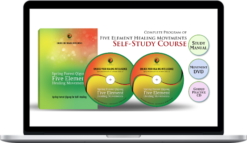Tanya Zajdel – Qigong For Sexual Trauma
$160.00 $30.00
»Delivery: Within 24hs
Description
Tanya Zajdel – Qigong For Sexual Trauma
Qigong For Sexual Trauma
The body is deeply affected by sexual trauma.
To aid on this complex journey of healing, Rewire Trauma Therapy has curated the Qigong For Sexual Trauma Program, an expert-led program that integrates the ancient Chinese wisdom of Qigong to help:
- Release trauma memory from the tissues
- Heal and ground the trauma-affected nervous system
- Release feelings of fear, loss, shame, and anger
- Cultivate feelings of safety and self-trust
- Reclaim confidence and empowerment
- Build a safe and pleasurable relationship within sexuality
“Our body has the miraculous capacity to mend itself and Qigong reawakens the natural healer within each of us.” – Deborah Davis
Our experience of trauma is internalized by our nervous system as a survival mechanism. When our intimate boundaries have been crossed, it is common to experience dissociation and shame (Vidal & Petrak, 2007).
Trauma survivors may continue to experience distress and challenging emotions, even after talk therapy.
According to leading experts such as Dr. Pat Ogden, Dr. Peter Levine, Dr. Bessel van der Kolk, and Dr Gabor Maté, the body is the key to healing trauma.
Qigong has been shown to be particularly helpful for trauma survivors as it activates the parasympathetic nervous system, aiding the body’s ability to move into a calmer state (Yeung et al., 2018).
Traditional Chinese Medicine understands poor health to be a cause of stagnant or blocked energy (qi) in the body (Yeung et al., 2018). Qigong works to release energy (qi) that is stuck in the body and to further balance one’s energy, strengthen the immune system, and improve mental well-being (Schnauzer, 2006).
The slow movement of Qigong can help to regulate five major systems:
- The nervous system
- The limbic system
- The circulatory systems
- The endocrine system
- The immune system
The practice of Qigong can create an attuned presence through its slow movements, diaphragmatic breathing, meditation, and maintenance of balance and coordination (Yeung et al., 2018). The combination of these principles can help to harness energy to support the flow of our qi (Yeung et al., 2018).
Qigong can help us activate our inner resources to instill a state of calm in the body. Some positive recorded outcomes of Qigong include:
- Feeling safe in your body
- Feeling grounded
- Feeling stronger in your body
- Feeling oriented in your environment
Qigong consists of mindful, meditative movements which are different from everyday activities as they tend to elicit personal experiences and sensations which link to emotion- aiding in cognitive processing (Pölönen et al., 2019).
Qigong can help to achieve a sense of awareness as well as the ability to observe thought patterns, without forming too much attachment to them (Shonin et al., 2013). Engaging in movement and breath while observing these thought patterns can encourage distressing or intrusive thoughts to pass by safely.
To make this powerful modality available to therapists and their clients, we’ve created this self-paced online program that integrates traditional Chinese Qigong to support trauma healing.
Introducing Qigong For Sexual Trauma
Discover a new science-backed way to integrate the ancient Chinese wisdom of Qigong to heal after sexual trauma and restore your boundaries.
Seven Expert-Guided Techniques:
Technique 1: Healing From Sexual Assault Through Qigong & Tantra
Using a Taoist Qigong practice of self-massage and breathwork, this exercise focuses on loving and nurturing yourself.
Technique 2: Healing Dissociation Through Qigong
Find groundedness through the Qigong practices of ‘soothing chi’ and ‘ocean breathing’. Using breath, intention, and movement, instill feelings of awareness and safety.
Technique 3: Sending Love To The Womb Through Qigong Meditation
Using a Taoist Qigong meditation known as the inner smile, this exercise helps to open the heart to experience feelings of love, joy, and gratitude and to send that energy to the pelvic area as a destressing technique for the pelvis.
Technique 4: Healing Sexual Shame Through Qigong
Build a positive relationship with your sexuality using the Qigong exercise of moving your hips in a figure-eight pattern- using our breath as we move. This exercise works to heal feelings of shame or guilt by balancing one’s energy.
Technique 5: Healing From Traumatic Childbirth Through Tantra & Qigong Practice
This exercise uses a Taoist Qigong, and Tantric practice called the ‘microcosmic orbit’. We begin with a body scan and then utilize breathwork while moving our hands in a circular motion over and around our pelvic area.
Technique 6: Releasing Shame, Loss, Fear & Anger From The Sexual Center Through Tantra
Shift feelings of anger and shame with the Taoist tantric practice called ‘wands of light’. This exercise draws on the five-element theory from traditional Chinese medicine.
Technique 7: Healing Anger, Helplessness, and Crossed Boundaries
Harness confidence and empowerment using a Qigong practice to create strong boundaries and a healthy sense of aggression. This exercise helps us connect to larger sources of energy and concentrate that energy into the lower energy center in our belly.
Two Expert-Led Theory Modules:
Theory Module 1: Introduction To Qigong (32-min)
- The background of Qigong and Tantra
- The three main foundations for Qigong
- Shifting Virtues
- Tantric-based Qigong
- The Yin and the Yang
Theory Module 2: Qigong Movements For Trauma Healing (15-min)
- Qigong exercise demonstrations
More courses from the same author: Tanya Zajdel
Delivery Policy
When will I receive my course?
You will receive a link to download your course immediately or within 1 to 21 days. It depends on the product you buy, so please read the short description of the product carefully before making a purchase.
How is my course delivered?
We share courses through Google Drive, so once your order is complete, you'll receive an invitation to view the course in your email.
To avoid any delay in delivery, please provide a Google mail and enter your email address correctly in the Checkout Page.
In case you submit a wrong email address, please contact us to resend the course to the correct email.
How do I check status of my order?
Please log in to HealingCourse account then go to Order Page. You will find all your orders includes number, date, status and total price.
If the status is Processing: Your course is being uploaded. Please be patient and wait for us to complete your order. If your order has multiple courses and one of them has not been updated with the download link, the status of the order is also Processing.
If the status is Completed: Your course is ready for immediate download. Click "VIEW" to view details and download the course.
Where can I find my course?
Once your order is complete, a link to download the course will automatically be sent to your email.
You can also get the download link by logging into your HealingCourse account then going to Downloads Page.
Related products
Total sold: 3
Total sold: 19










